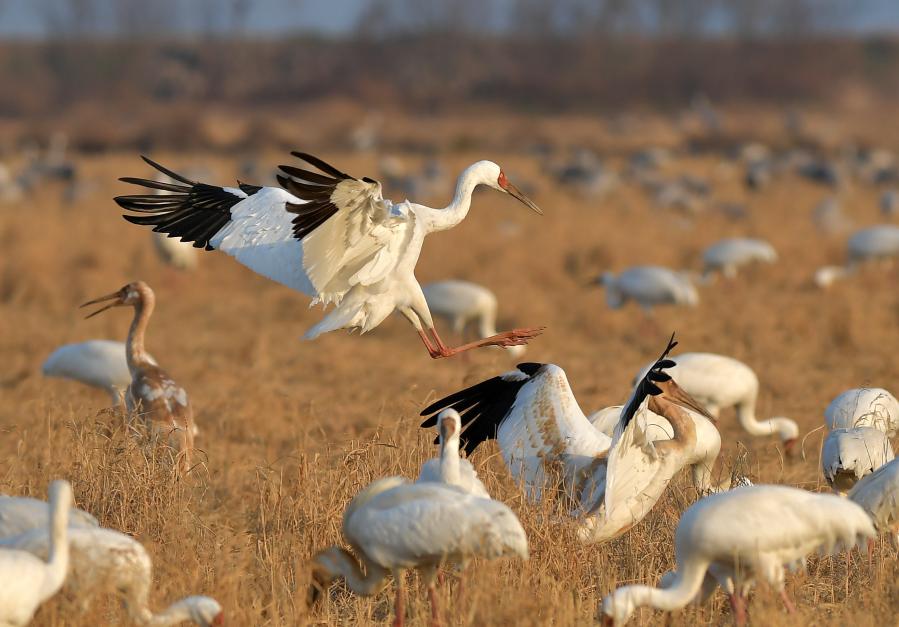Restoring Earth, China on the move to achieve carbon neutrality, more biodiversity
-- Themed "Restoring Our Earth," the 52nd Earth Day falls on Thursday, with countries worldwide making commitments addressing the common environmental challenges the planet faces.
-- In its exploration to address the environmental challenges, China aims to work closely with its global partners, and honor its commitments while encouraging others to do so.
-- To reach the country's climate pledge, China should further accelerate its energy transformation, and increase the share of renewables in the energy mix.
BEIJING -- Themed "Restoring Our Earth," the 52nd Earth Day falls on Thursday, with countries worldwide making commitments addressing the common environmental challenges the planet faces.
China has taken steps toward a low-carbon transition, with progress made in tackling climate change and protecting biodiversity -- two urgent agendas that call for global collaboration, said Beate Trankmann, United Nations Development Programme (UNDP) Resident Representative in China.
"As the world attempts to build back better from the pandemic, concerted global action is needed to address climate change and safeguard the capacity of the Earth to support life by protecting the balance of ecosystems," Trankmann said in an interview with Xinhua.
In its exploration to address the environmental challenges, China aims to work closely with its global partners, and honor its commitments while encouraging others to do so.

Aerial photo taken on Feb. 24, 2020 shows the Haizhu wetland and the Canton Tower in the distance in Guangzhou, south China's Guangdong Province. [Photo by Xie Huiqiang/Xinhua]
ADDRESSING CLIMATE CHANGE
Facing the global climate problem, China has announced its goal to peak its carbon dioxide emissions before 2030 and become carbon-neutral by 2060.
The country has reaffirmed its climate commitment with clear targets in the 14th Five-Year Plan (2021-2025), the country's social and economic development roadmap.
According to the plan, China aims to significantly lower the energy consumption per unit of gross domestic product (GDP) and its carbon dioxide emissions (CO2) by 13.5 percent and 18 percent, respectively, during the 2021-2025 period.
China's recent climate pledges could accelerate the global fight against climate change, and could set an example to other countries, encouraging them to step up their commitments, too, said Trankmann.
Last year, an ultra-high-voltage (UHV) line that only transmits clean power, including wind, solar and hydro energy, from northwest China's Qinghai Province to Henan in central China went into operation.
As the world's first UHV to transmit only carbon-free electricity, the line could offer as much as 40 billion kilowatt-hours of power annually to central China, reducing 29.6 million tonnes of CO2 emissions.
"China is a driver of much of the technological innovation needed to fight climate change," said Trankmann, adding that the country is now a global leader in renewable energy.
Last year, power generated by renewable energy sources hit 2.2 trillion kilowatt-hours, accounting for 29.5 percent of the country's total electricity consumption, up by 9.5 percentage points from 2012.
China has also carried out institutional innovations, from launching carbon-trading schemes to developing green finance.
Since 2011, China has piloted the trading of carbon emissions in provinces and cities, including Beijing, Shanghai, and Hubei, to draw on a market-based mechanism for greenhouse control.
Looking ahead, China's investments into innovation and experimentation in the green economy certainly offer opportunities to make green growth more viable, said Trankmann.

Aerial photo taken on April 16, 2021 shows facilities of a solar thermal electricity project in Gonghe County, Tibetan Autonomous Prefecture of Hainan in northwest China's Qinghai Province. [Xinhua/Zhang Hongxiang]
PROTECTING BIODIVERSITY
After a journey of over 5,000 km across mountains and rivers, the Siberian white cranes land at Poyang Lake in east China's Jiangxi Province, the place they call home, each winter.
Rated as critically endangered on the International Union for Conservation of Nature Red List, the Siberian white crane, also known as the snow crane, have seen their numbers dwindle to 4,000, with only a single migrating route left -- the east route to Poyang Lake.
Thanks to sustained efforts to preserve the habitat for the birds, the country's largest freshwater lake saw an increasing number of feathery visitors, attracting more than 680,000 wintering birds in 2020, 11,000 more than the previous year.
"The species and population of migratory birds have increased significantly in some important lakes and wetlands along the Yangtze River, which reflects an improvement in the local ecological environment," said Chen Jiakuan, a professor specializing in ecology with Fudan University.
China has made significant progress in protecting its wetlands with the help of its global partners. Local governments have been working with international institutions such as the Global Environment Facility and UNDP to finance and implement environmental projects.
As a result of UNDP-China cooperation, China's protected areas increased by 1.9 million hectares across six provincial regions, Trankmann noted.
She said that biodiversity protection is very much related to the fight against climate change, as intact ecosystems help absorb carbon and maintain animal habitats and food security.
As another attempt to draw global efforts to restore ecology on Earth, China will host the 15th meeting of the Conference of the Parties to the Convention on Biological Diversity (COP15) in Kunming of the southwest Yunnan Province this year. Countries are expected to work out concrete plans for post-2020 global biodiversity protection.
"This needs to include taking environmental issues into the heart of economic and financial decision-making and rethinking how public and private finance can co-generate positive effects for biodiversity. As the host, China has an opportunity to push this agenda," Trankmann said.

White cranes forage in a farmland by the Poyang Lake in Yugan County, east China's Jiangxi Province, Jan. 15, 2021. [Xinhua/Peng Zhaozhi]
CHALLENGES AHEAD
Coal-fired power remains a major energy source in China, and the country vows to bring the share of coal in total energy consumption to under 56 percent in 2021.
To reach the country's climate pledge, Trankmann believes that China should further accelerate its energy transformation, and increase the share of renewables in the energy mix.
According to an industrial report released by the China National Coal Association, the country's annual coal output will stand at no higher than 4.1 billion tonnes by the end of the 14th Five-Year Plan period (2021-2025). The annual coal consumption will be kept to around 4.2 billion tonnes at the end of 2025.
"We look forward to more targets and strategies for how to achieve a reduction in total emissions in the five-year plans for different sectors later this year including curbing coal consumption," she said.
In terms of addressing the challenges of protecting biodiversity, Trankmann said more could be done.
"Policies for biodiversity protection should be strengthened and tailored to different ecological contexts along with integrated approaches to land and resource management, including coastal and river basin management," said Trankmann.
Additionally, China can expand on its Grain for Green program, whereby people who live in ecologically fragile environments receive compensation for protecting ecosystems and conserving biodiversity.
Video reporters: Yu Gang, Liu Bin, Peng Jing; Video editor: Yang Zhixiang
























